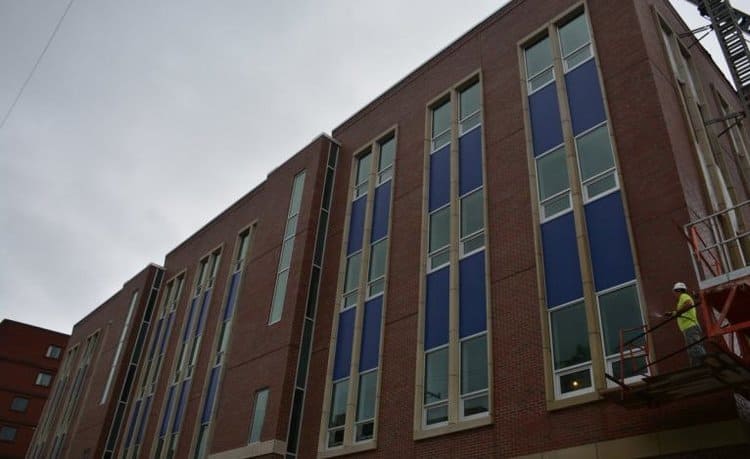
Central Catholic unveils new Zupancic Family STEM Center
Demarre Evans, a 12th-grader at Central Catholic High School, wrote this article, which first appeared in Pittsburgh Youth Media, a program of Youth Express.
Central Catholic High School in Oakland started the 2016-17 school year with an addition to campus that focuses on science, technology, engineering and math (STEM). The Zupancic Family STEM Education Center is a new building housing all of the school’s science classes, as well as a few engineering classes. The new building has a total of 12 lab spaces.
I had the opportunity to interview the principal of the school, Br. Anthony Baginski, about the Zupancic Family STEM Education Center and the importance of a STEM education in order to get more information about the construction and the reasoning behind it.
Demarre Evans: Why do you feel that a STEM education is important?
Br. Anthony Baginski: Any education that makes students think critically is important. Whether that is in the liberal arts, philosophy, or STEM; the most important things are the ability to think critically, to argue from evidence, and to see the connection between what we do as our job and how that impacts society and the world. I happen to believe and I know that since the 19th century our society has become more technologically complex. I’m not saying that other fields are not important, it is just the science, technology, engineering, and the mathematics has become more important in our society. However, that has to be coupled with a respect, and ethical and moral framework to say not only can we do something but is this the correct thing to do.
DE: Though not all schools have the ability to build a new building strictly for STEM, should they still make an attempt to emphasize how important STEM is going to be in the near future?
AB: A good education has those key points that I mentioned earlier (in the previous question). However, it doesn’t take a new building. We have been blessed and very fortunate to have our alumni that support this endeavor and because of that we can do many things we could do many things that otherwise beforehand we could not do. However, you could still do STEM-related education without the facilities. In computer science, there is a thing called computational thinking that you can do with pencil and paper, it doesn’t require high-tech equipment. However, a lot of the jobs that are available out there do require a familiarity with expensive, intricate and complex computer programs and with different machines. That is one of the pluses of having a STEM facility like this, as well as it has been a wonderful recruitment tool for the faculty that we have been able to hire. So we have top-notch faculty who have been able to see the value and are putting into place what we are offering at Central Catholic.

DE: What was the reasoning behind the new STEM Building?
AB: We started a self-evaluation study about five years ago to say what we need to do to prepare our graduates for college and for life. One of the things we found that we were lacking were the facilities for our science programs and also computer science and engineering needing more space to have long-term projects. Some of these 21st-century skills, besides the knowledge component, talk about teamwork, collaboration and the engineering process where you have an idea on how to solve a problem, then you have to construct something, make it fail, and then redesign it and build it again. We started off by saying what do our students need to be as successful as possible in the 21st century. The result of that was a strong liberal arts foundation with these additional opportunities in STEM education.
DE: With STEM standing for science, technology, engineering, and mathematics, some people have been adding the letter A, standing for art, to make STEAM. Do you feel that art has validity to be added to STEM?
AB: We are incorporating as many disciplines as possible. So yes, as all of the disciplines should be interrelated. So the conversation was, “Do we put the ‘A’ in for art, do we put an ‘M’ in for medical, do we put an ‘R’ in for religion?” We are saying no because all of these things we want to incorporate into our STEM program, and we want our STEM program to be incorporated into our curriculum. We decide to leave it at STEM, not because we are excluding someone, but because are going to include these cross-curricular components.
In America, a lot of jobs are requiring basic technological knowledge, such as the ability to use a computer. Technologies and such skills found in STEM are becoming more advanced and Central Catholic is simply just capitalizing on this because they realize that more students are going to want to go into these fields and if not, they are still going to need a basic knowledge of some of these things. Currently, more than 50 percent of jobs require a degree of technology skills. Some experts even say that it will rise to 77 percent within the next decade. So it is safe to say that STEM is where the money is.